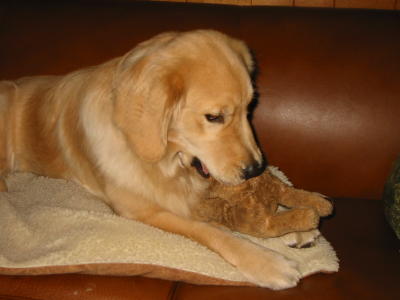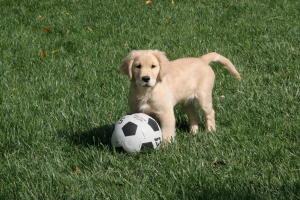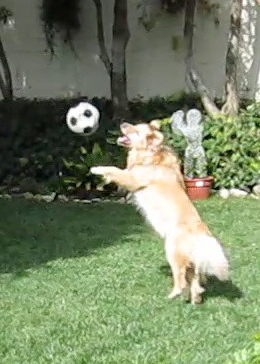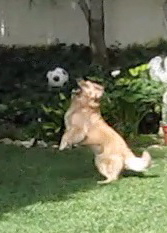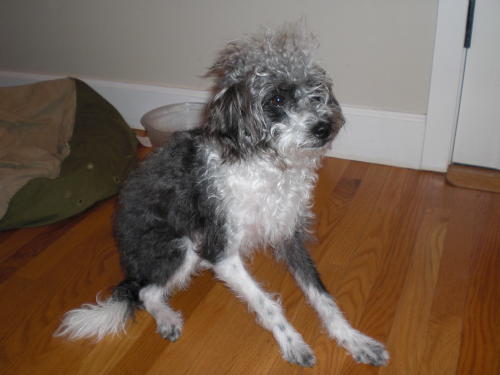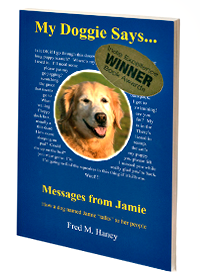“Dogbonding” is a process of building a close relationship with your dog.
If you would like to have a closer relationship with your dog, you will want to remember some of the pointers in this article.
Much of dog training is about obedience – getting your dog to pee outside, not chew the furniture, come when called, etc. This kind of training is obviously important. You might save your dog’s life by getting it to “come” away from the path of a speeding car.
To achieve the full potential of your relationship with your dog, though, you need to get past obedience training and into activities where there is true interaction – give and take at your pet’s level.
Every day, Callie, my Golden Retriever, and I play soccer together. When Callie arrived at our house as an eight-week-old puppy, she squatted down behind an old soccer ball. She looked me in the eye as if to say, “OK, Fred, show me what you’ve got!” Since then, we have played soccer almost every day. My kicking has improved, and Callie has advanced from trapping the ball under her tummy to leaping in the air to do “nosers” – Callie’s version of a “header.” We interact in the same way that you would if you were practicing soccer with another person.
The essential ingredient of my soccer experience with Callie is that it was her idea – her invitation. And every day, it’s Callie who invites me — rather, “begs me” — to go outside and play soccer. She finds me in the house, makes eye contact, and turns to run outside. Then she stops and looks back to see if I am following her. If I am not cooperating, she lopes back to my side and starts again with the eye contact.
As a concession to “alpha” theory, I initiate the game by bringing the soccer ball out of its storage place, and I finish the game by putting the ball back where it belongs. But the game itself is an equal give-and-take between Callie and me.
This is where “dog-bonding” can come into conflict with some modern theories of dog training. Proponents of “all alpha all the time,” for example, put the emphasis on the owner being “top dog.” These people admonish dog owners “never to play tug-of-war with their pet.”
But tug-of-war can be a great give-and-take game to play with your dog – provided that (to make the “alpha” folks happy) it isn’t taken to the point that the dog’s behavior becomes aggressive. Next time your dog brings you a toy, or some other object, take it in your hand, but don’t wrench it away from your dog. See what it wants to do. And then try letting the dog decide the game. If it wants to play “give and take,” let it. If it wants to play “tug-of-war,” let it – without allowing your dog to become aggressive. You might find that your dog wants to play “let’s just both hold this for a while.” It seems to give them lots of satisfaction.
There is definitely a place for “alpha.” It’s just overdone sometimes. When Callie was a puppy and jumping up on our three and five-year-old granddaughters, we asked dog trainer Brian Lee for help. In two hours time, Brian worked magic with Callie, and part of the solution was not letting her sleep on our bed. This was subtle, but it seemed to reinforce some family hierarchy in Callie’s mind.
Some of my other favorite dog-bonding moments are:
• Callie’s daily “good morning” ritual. When she sees that I am awake, she walks to my side of the bed, drapes her nose on the edge of the bed, and “snorts” (literally) until I scratch her neck for a while. It’s a very special dog-bonding way to start the day.
• Our morning jog is always a shared adventure. Callie does a good job of “heeling,” but sometimes she asks politely if she can greet a friend – sometimes a favorite doggie friend, sometimes a favorite people friend.
• During the day, when I am working in my office, Callie is always close. Several times a day, she walks into my office, puts a paw on my knee, and asks for a little attention. Sometimes, she snorts, which is her way of getting my attention. Sometimes it’s a very short snort, but sometimes she continues to snort, as if she is trying to mimic human conversation. It’s very charming.
And it’s not just about dog-bonding with me. Callie has a great relationship with one of her favorite people friends, Jeff, a greens-keeper at the nearby golf club. Callie absolutely adores Jeff. Sometimes, Jeff endears himself to Callie by presenting her with a tennis ball, but Callie would love Jeff even if there were no tennis balls. If he can afford the time, Jeff gets out of his golf cart and gives Callie a nice scratch on her chest.
Ted Kerasote, author of “Merle’s Door,” and a guest on my talk show, suggests letting your dog “read the news” on your morning walk. He says, “I spend ten or fifteen minutes reading the news every morning; why not let Merle do the same thing?” By “reading the news” Ted means letting your dog have plenty of time to sniff around your neighborhood. That’s a dog’s way of knowing what’s been happening in its world. Try it; your dog will love you for it!
Another guest on the “My Doggie Says…” talk show, Kyra Sundance, has published several books about how to teach your dog tricks. Teaching your dog tricks is an excellent way to spend some quality time with your dog – and improve your relationship. You and your dog learn together, and your dog will appreciate the time you spend with it – and the attention it gets from you.
Invent your own forms of dogbonding. The important thing is to share experiences with your dog; to do things that it enjoys doing. It will be grateful to you for spending the time, and you will find your doggie relationship moving to a higher level.
